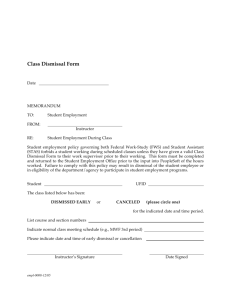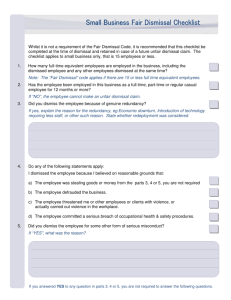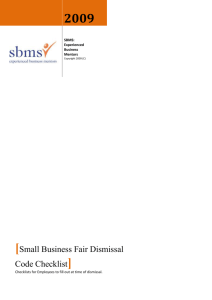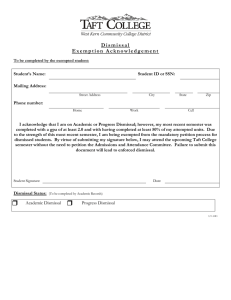Dismissing employees
advertisement
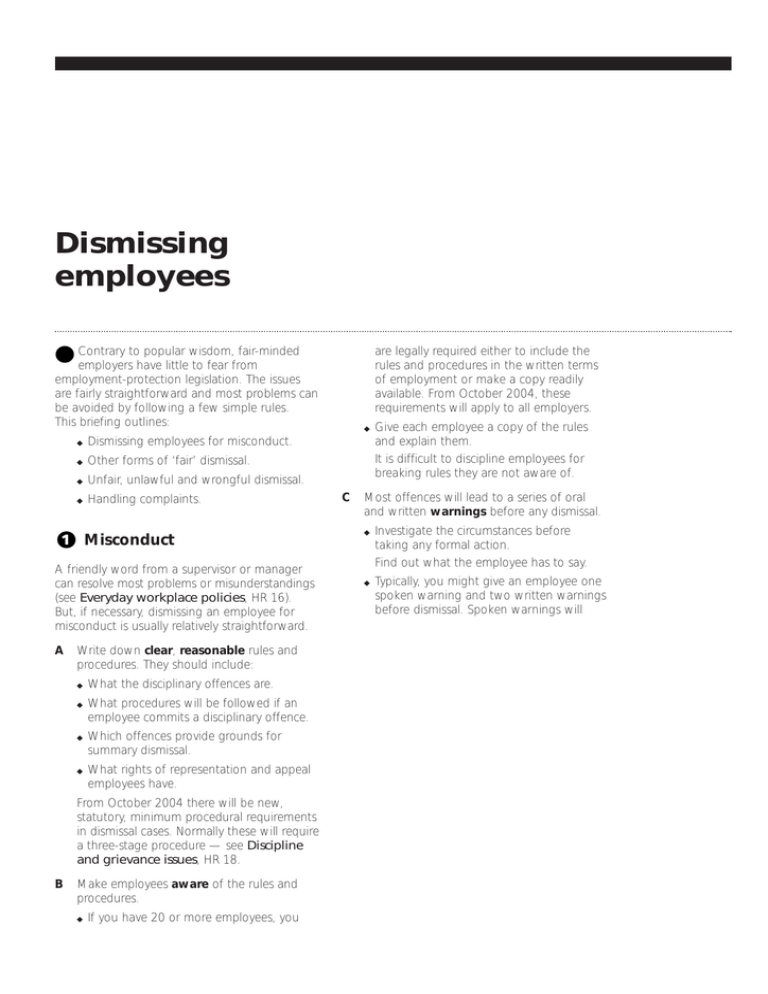
Dismissing employees are legally required either to include the rules and procedures in the written terms of employment or make a copy readily available. From October 2004, these requirements will apply to all employers. Contrary to popular wisdom, fair-minded employers have little to fear from employment-protection legislation. The issues are fairly straightforward and most problems can be avoided by following a few simple rules. This briefing outlines: ◆ Dismissing employees for misconduct. ◆ Other forms of ‘fair’ dismissal. ◆ Unfair, unlawful and wrongful dismissal. ◆ Handling complaints. Misconduct A friendly word from a supervisor or manager can resolve most problems or misunderstandings (see Everyday workplace policies, HR 16). But, if necessary, dismissing an employee for misconduct is usually relatively straightforward. A Write down clear, reasonable rules and procedures. They should include: ◆ What the disciplinary offences are. ◆ What procedures will be followed if an employee commits a disciplinary offence. ◆ Which offences provide grounds for summary dismissal. ◆ What rights of representation and appeal employees have. From October 2004 there will be new, statutory, minimum procedural requirements in dismissal cases. Normally these will require a three-stage procedure — see Discipline and grievance issues, HR 18. B Make employees aware of the rules and procedures. ◆ If you have 20 or more employees, you ◆ C Give each employee a copy of the rules and explain them. It is difficult to discipline employees for breaking rules they are not aware of. Most offences will lead to a series of oral and written warnings before any dismissal. ◆ Investigate the circumstances before taking any formal action. Find out what the employee has to say. ◆ Typically, you might give an employee one spoken warning and two written warnings before dismissal. Spoken warnings will often be removed from an employee’s disciplinary record after six months, and written warnings after 12 months (if the employee has not committed further disciplinary offences). ◆ ◆ E A formal warning should include a time limit within which you expect improvement, and an explanation of the consequences otherwise. Apply the rules fairly and consistently. An employee who can show that you applied the rules inconsistently may be able to claim unfair dismissal (see 4). ◆ Keep written records of all disciplinary action you take. Include a record of any steps you have taken to investigate and address the cause of the problem. ◆ All employees have the right to be accompanied by a colleague or trade union official at any disciplinary hearing. ◆ Remind employees of their right to explain their conduct or suggest counter-proposals. If an employee has more than a year’s service, failure to follow a fair procedure is usually grounds for a complaint of unfair dismissal, irrespective of the reason for the dismissal. D ‘Gross misconduct’ can provide grounds for summary dismissal without notice. In practice, you should always suspend the employee on full pay and investigate the incident before dismissal. Gross misconduct typically includes: ◆ Theft or fraud. ◆ Fighting or physical assault. ◆ Drunkenness or drug-taking at work. Short service Employees with less than one year’s service cannot claim unfair dismissal. However: ◆ ◆ You risk losing the respect and confidence of other employees if you behave unreasonably. You cannot dismiss any employee for unlawful or inadmissible reasons (see 4B and 4C) or simply breach the contract (see 4D). ◆ You must give the employee the appropriate notice (see 1F). ◆ Any employee with at least one month’s service is protected against unreasonable dismissal on certain medical grounds. From October 2004, you are legally obliged to apply the new minimum procedures to all employees, regardless of length of service. F ◆ Wilful damage to company property. ◆ Intentional or reckless disregard for safety and hygiene rules. Give employees the right to appeal against disciplinary decisions and dismissal. ◆ State the name or job title of the person responsible for hearing any appeals. ◆ Where possible, the person dealing with the appeal should not have been involved at any prior stage of the proceedings. Give employees the appropriate notice. ◆ After a month’s employment, an employee has a statutory entitlement to one week’s notice (unless summarily dismissed). After the first year, an employee is entitled to an extra week’s notice for each additional year of continuous service. The maximum statutory entitlement is 12 weeks’ notice (after 12 years of service). ◆ The contract of employment may entitle the employee to a longer period of notice. An employee dismissed without proper notice can claim wrongful dismissal. G Provide written reasons for the dismissal. You are legally required to do this: ◆ Within 14 days of a written request from an employee who has completed at least one years’ continuous employment. ◆ Whenever you dismiss an employee who is pregnant or on maternity leave, whether asked to or not and regardless of how long she has worked for you. Inability to perform Normally, new recruits who are incompetent or under-qualified will be discovered fairly quickly. They can then be dismissed without running the risk of a claim of unfair dismissal (see box). A There are four ‘permitted’ reasons for dismissing employees who are unable to perform their jobs: ◆ Incompetence (lacking the skills or aptitude to carry out duties effectively). ◆ Lack of relevant academic, technical or professional qualifications. ◆ Sickness or injury (usually associated with frequent or prolonged absenteeism). However, a long-term sickness or injury may qualify as a disability (see 4C). (See Sickness issues and SSP, HR 23.) ◆ Because it would be illegal for the employee to carry on working in the job. page 2 For example, if the employee’s work permit expires or the employee loses the required driving licence. B You must be able to demonstrate that you acted fairly and reasonably both in deciding to dismiss and the way you did it. ◆ ◆ Did you investigate the circumstances fully? For example, did you find out how long it would take the employee to recover from illness and whether you could use a temporary worker in the meantime? ◆ Did you consider alternative options? For example, transferring the employee to another job or offering part-time work. ◆ ◆ ◆ C Was the employee really unable to perform or was it an excuse for dismissal? For example, has the employee carried out duties satisfactorily, despite the lack of qualifications? Unfair and unlawful dismissal A An employee with at least one year’s service who is under 65 (or the normal retiring age for a person doing that job) is protected against dismissal. Unless the employee was reasonably dismissed, he or she can claim unfair dismissal. ◆ Compensation for unfair dismissal is made up of a basic award, taking account of age and service and capped at £8,100, and a ‘compensatory award’. The upper limit on these compensatory awards is £55,000 and they may include an element for psychological distress and damage to reputation, as well as economic loss. B Did you (where needed) provide appropriate advice, counselling, training or supervision? For example, did you promote or transfer the employee without suitable training? Did you set out your concerns in writing, give the employee time to consider them, then discuss them with him or her and listen to his or her views? If an employee is dismissed, he or she must be given appropriate notice (see 1F) and may be entitled to written reasons (see 1G). Other permitted reasons A You can dismiss an employee because of redundancy (see Redundancy, HR 20). For example, if a business (or part of a business) closes, relocates or is restructured, or there is a reduced need for employees doing a certain kind of work. B The redundancy must be genuine. ◆ There are special rules governing the selection of employees for redundancy and the procedures to follow. You can dismiss an employee for ‘some other substantial reason’. For example, a refusal to co-operate with a generally accepted change in working practices which is required for the profitability or survival of the business. ◆ Regardless of age or length of service, it is an inadmissible reason (and automatically unfair) to dismiss any employee for: ◆ Being pregnant, giving birth or taking advantage of statutory maternity rights. (See Maternity issues and SMP, HR 22.) An employee who fails to return to work after maternity leave will be held to have terminated her own employment (unless the leave is extended on medical grounds). ◆ Carrying out (or proposing to carry out) functions as an appointed or elected safety representative or as a member of a safety committee. ◆ Pointing out or reacting to imminent risks to health and safety. ◆ Carrying out (or proposing to carry out) functions as an employee representative. ◆ Membership (or non-membership) of a trade union, or for taking part in the activities of an independent trade union. It is unwise to dismiss a shop steward, for any reason, without first discussing it with a full-time union official. ◆ Carrying out (or proposing to carry out) functions as a pension scheme trustee. ◆ Questioning or challenging your apparent disregard for statutory employment rights. ◆ Reporting superiors or colleagues for illegal or dangerous activities to an internal or external authority (‘whistleblowing’). Did you ensure that the employee knew about his or her right to appeal? ◆ You must be ‘reasonable’. For example, exploring the possibility of an alternative job for the employee. The only permitted reasons are those given in 1, 2 and 3. C Regardless of age or length of service, it is unlawful to dismiss any employee on the grounds of: ◆ Sex or marital status. ◆ Colour, race, nationality or national or ethnic origins. page 3 ◆ Disability — this may include a physical or mental illness likely to last at least a year. weeks. You must also have taken reasonable steps to resolve the dispute. ◆ Sexual orientation, whether actual or perceived. ◆ ◆ Religion or philosophical belief. If you get this wrong, it will be unfair dismissal. At the worst, you could face a compensatory employment tribunal award of up to £55,000, plus a basic award, based on the employee’s age and service. ◆ Employees taking unofficial strike action can be dismissed. D An employee may resign and claim unfair constructive dismissal if your conduct as an employer has breached a fundamental term of the employment contract. This might include anything that makes it impossible or intolerable for the employee to continue doing the job. E ◆ Cutting (or attempting to cut) an employee’s wages or salary or other contractual benefits. ◆ Transferring an employee to a different job or location in the absence of any express or implied contractual right to do so. ◆ Failing to provide a safe place of work. ◆ Subjecting a supervisor or manager to unwarranted abuse or criticism in the presence of colleagues or subordinates. C You can dismiss a temporary replacement once the permanent employee returns to work (eg after maternity leave). ◆ Complaints and help A If you know that an employee intends to complain to an employment tribunal, ask your local Acas office for advice and for the services of a conciliator. From October 2004 employees must have tried to get matters redressed through the grievance procedure, before they can claim constructive dismissal. ◆ Do so before the employee presents the complaint to the tribunal. A conciliator will contact both you and the employee anyway, once a complaint has been made. Dismissing employees in connection with the purchase, sale or transfer of a business is usually unfair under the ‘TUPE’ regulations. ◆ A conciliator cannot help without the consent of both you and the employee. B You cannot dismiss employees unless you have a sound economic, technical or organisational reason requiring a change. ◆ Dismissing an employee to facilitate the sale of a business is likely to be unfair. It may be possible to reach an ‘out of court’ agreement. Only two forms of agreement are legally binding: ◆ A ‘COT3’ agreement reached with the participation of an Acas officer. ◆ A ‘compromise agreement’ in a suitable form where the employee has had appropriate independent legal advice. Special cases C Some of the more common situations which lead to confusion or problems are outlined below. If in doubt, take legal advice. A Many directors are both office-holders and employees. ◆ ◆ B You must have informed the replacement employee, in writing, when first employed, that this would happen. A director may be removed from office in accordance with the company’s Articles of Association or the requirements of the Companies Act 1985. This does not necessarily affect the director’s employment status. A director who is also an employee has the same legal protection against unfair or unlawful dismissal as other employees. You cannot usually dismiss employees taking ‘protected’ (official) industrial action, unless this has gone on for more than eight Once an employee has complained to a tribunal, you will be sent form IT 3 (due to be renamed ET3 in October 2004). The form asks whether you intend to contest the complaint and if so, what your grounds are. ◆ Return the completed form within 21 days. Otherwise you may lose your right to take part in the tribunal hearing. D Most experienced personnel managers will have little difficulty justifying the fairness and legality of their employers’ actions before an employment tribunal without support. ◆ You may want to involve a solicitor (or personnel consultant) who specialises in employment law if you are unsure of your grounds, as the outcome could have major implications for your business. See Employment tribunals, HR 21. page 4
